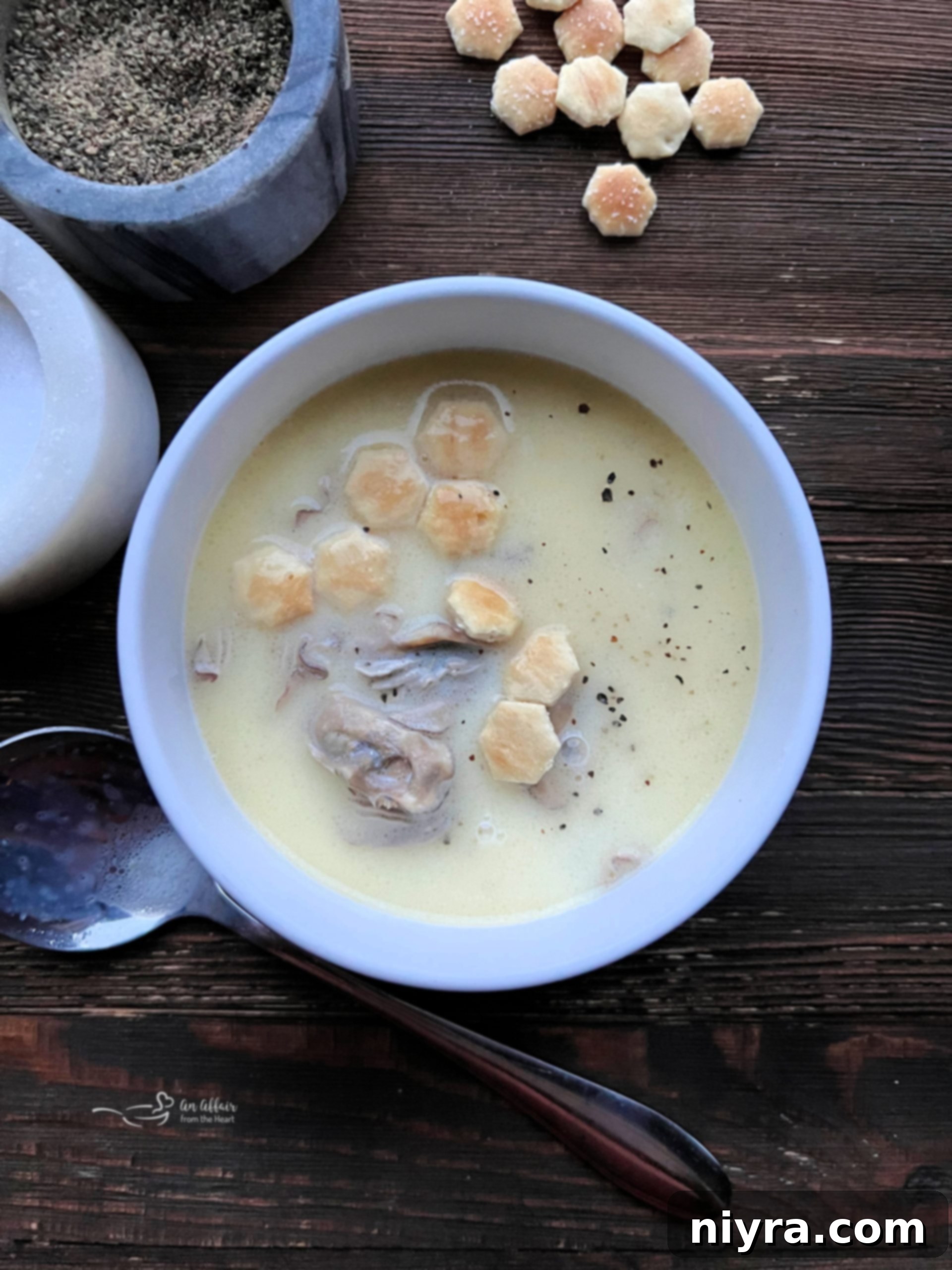Oyster Stew is the quintessential comfort food, offering a luxurious blend of tender oysters gently simmered in a rich, velvety, butter-infused milk-based broth. This classic, time-honored recipe masterfully highlights the delicate, sweet brininess of fresh oysters, relying on just a handful of simple yet high-quality ingredients. Whether you’re seeking a soul-warming dish to chase away the winter chill or a special culinary indulgence for festive occasions like Christmas Eve, a warm bowl of this hearty stew is sure to delight. Its creamy texture and subtle flavors make it a beloved dish that transcends mere sustenance, becoming a cherished experience.
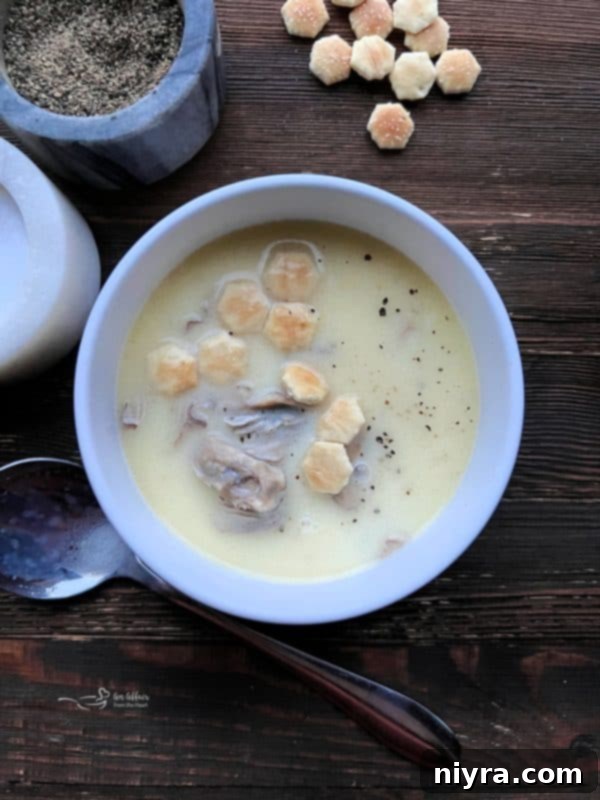
This Oyster Stew recipe holds a deeply special place in my heart, evoking a cascade of cherished childhood memories. Each year, our final enchanting stop on Christmas Eve was always at my Grandpa and Grandma Martin’s welcoming home. It was there, amidst the festive cheer and familial warmth, that we always enjoyed a traditional oyster stew. What made it even more memorable was that they would patiently await my arrival, knowing my uncles relished the playful challenge of trying to “scare” me with a raw oyster – a feat they could never accomplish! Every Christmas Eve, we’d gather, slurp down raw oysters with gleeful abandon, and I’d feel so grown up helping to prepare the oyster soup. This beautiful Christmas Eve tradition, rich with laughter and delicious flavors, is one I’ve proudly carried into my adult life, ensuring its legacy continues.

This candid photograph captures a moment from 1985, featuring me in my grandparents’ kitchen, thoroughly enjoying my oyster. I recall that day with such vivid clarity – the warmth of the kitchen, the buzz of family, and the unique taste of the oysters. It’s a snapshot of a treasured memory that perfectly embodies the spirit of our family tradition. Today, as I continue the tradition of making this beloved stew, those who are brave enough partake in their own raw oyster photo opportunity. These photos are then immediately texted to my dad and uncles, a small gesture that keeps our family connection strong and the festive memories alive across generations.
While you’re here exploring the delights of comforting stews, be sure to check out some of these other fantastic recipes: Mulligan Stew, a hearty classic; Taco Stew, a flavorful twist on a family favorite; and Rustic Harvest Stew, perfect for cozy autumn evenings.
Why Oyster Stew on Christmas Eve? Unraveling a Cherished Tradition
The tradition of enjoying oyster stew on Christmas Eve is a fascinating blend of historical circumstance, religious custom, and the timeless appeal of a special meal. For centuries, oysters were regarded as a luxury food item, making their presence at the Christmas Eve table a declaration of festivity and indulgence. This culinary custom primarily originated within Irish Catholic communities, gradually expanding its reach into mainstream American culture.
Historically, Catholic fasting restrictions dictated that no meat could be consumed on Christmas Eve. In this context, oyster stew emerged as an ideal solution. Oysters provided a highly satisfying, protein-rich dish that readily circumvented the “no meat” rule. Furthermore, oysters were remarkably abundant and, crucially, one of the few fresh foods that were readily available during the cold winter months. This made them a practical and delicious choice when other fresh provisions were scarce.
Beyond the practical and religious reasons, the enduring popularity of oyster stew on Christmas Eve is deeply rooted in nostalgia and sentimental meaning. It’s a tradition that evokes warmth, family gatherings, and shared memories, making it a beloved ritual that many families, including my own, proudly continue for generations. It’s more than just a meal; it’s a connection to the past, a symbol of togetherness, and a taste of home that defines the holiday season for many.

Classic Oyster Stew: A Timeless and Effortless Recipe
Oyster stew is a truly timeless dish, revered for its exquisitely velvety texture and the delicate, subtle flavor of fresh oysters. While many stews demand hours of simmering to develop their rich profiles, this creamy oyster stew recipe is a remarkable exception. It comes together in less than 30 minutes, making it an ideal choice for a quick yet luxurious meal! The result is a wonderfully creamy, soul-warming dish that is absolutely perfect for warding off the chill on a cold winter day. Beyond Christmas Eve, my Mom frequently prepared oyster stew during Lent, showcasing its versatility as a satisfying, meat-free option for various occasions throughout the year. Its simplicity belies its depth of flavor, proving that some of the best culinary experiences require minimal effort.
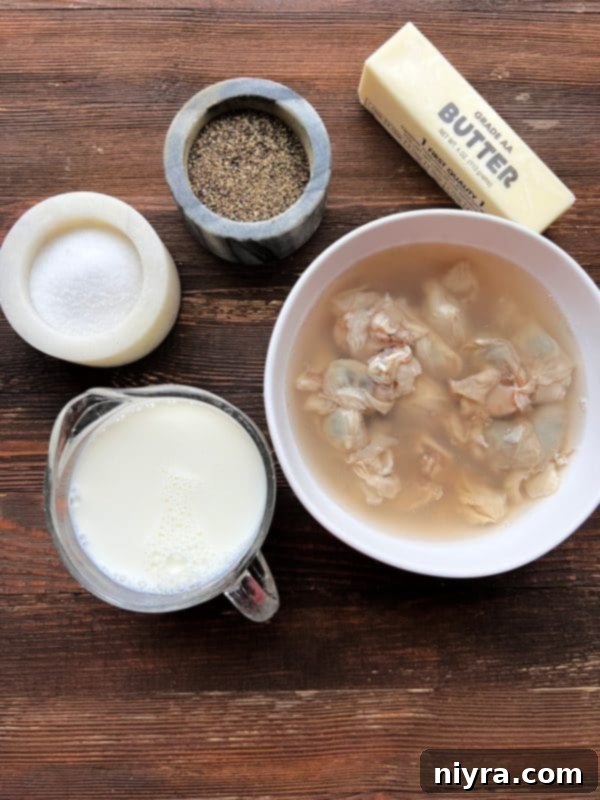
Essential Ingredients for Homemade Oyster Stew
Crafting this easy and delectable oyster stew requires just a few key components. For a full, detailed list of ingredients and step-by-step instructions, please refer to the printable recipe card conveniently located at the bottom of this post.
To prepare this classic, heartwarming stew, you’ll need:
- Fresh Raw Oysters: These are the star of the show, providing the essential briny flavor and tender texture. Crucially, don’t discard the natural liquid they come in, as it’s vital for building the stew’s depth of flavor. I always opt for raw shucked oysters from the seafood counter at my local grocery store for the best quality. However, if fresh oysters are difficult to procure, I’ve included instructions later in this post for successfully using canned oysters, ensuring everyone can enjoy this dish.
- Butter: Abundant, high-quality butter is fundamental to achieving the rich, luxurious broth that defines a truly exceptional oyster stew. I prefer using salted butter to enhance the overall flavor.
- Whole Milk: This forms the creamy base of the stew. For an even richer, more decadent stew, you can substitute heavy cream or a half-and-half mixture. Be mindful that using skim milk will significantly alter both the taste and the desired thick, creamy consistency of the stew, resulting in a thinner broth.
- Salt and Black Pepper: Simple seasonings are all that’s needed to perfectly balance and elevate the natural flavors of the oysters and the rich dairy. Always season to taste, adjusting as needed after the stew has simmered.
- Oyster Crackers: These small, crisp crackers are the traditional accompaniment to oyster stew, perfect for adding texture and soaking up the delicious broth. Ensure you have plenty on hand, or opt for classic saltine crackers as a suitable alternative.
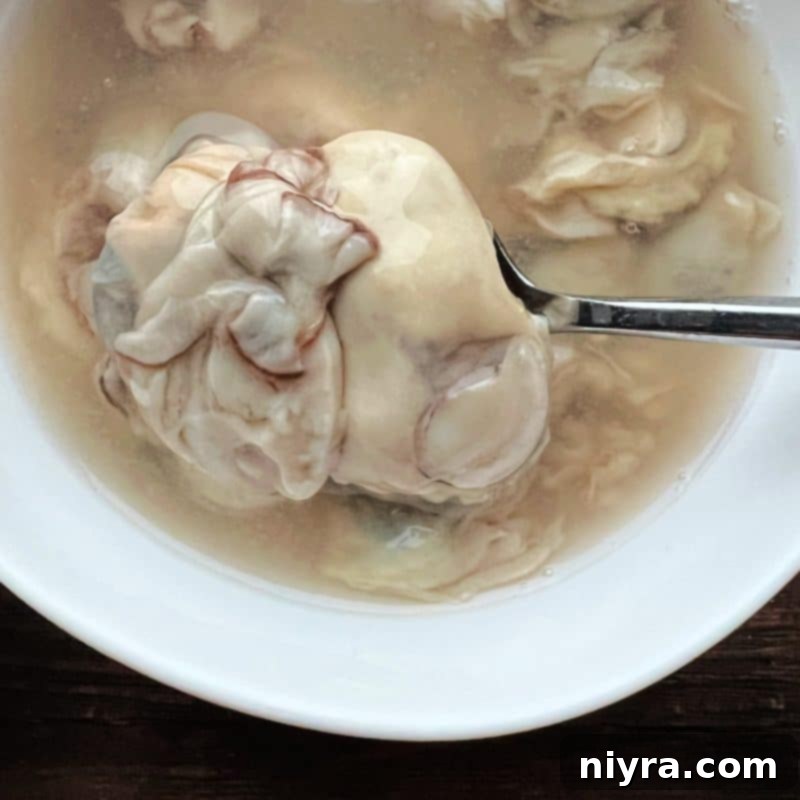
The foundation of this incredible stew lies in two key components: fresh-shucked oysters, which infuse the broth with their distinctive and essential briny flavor, and the generous use of whole milk or heavy cream, which contributes to its wonderfully rich and velvety texture. These elements combine to create a truly unforgettable culinary experience.
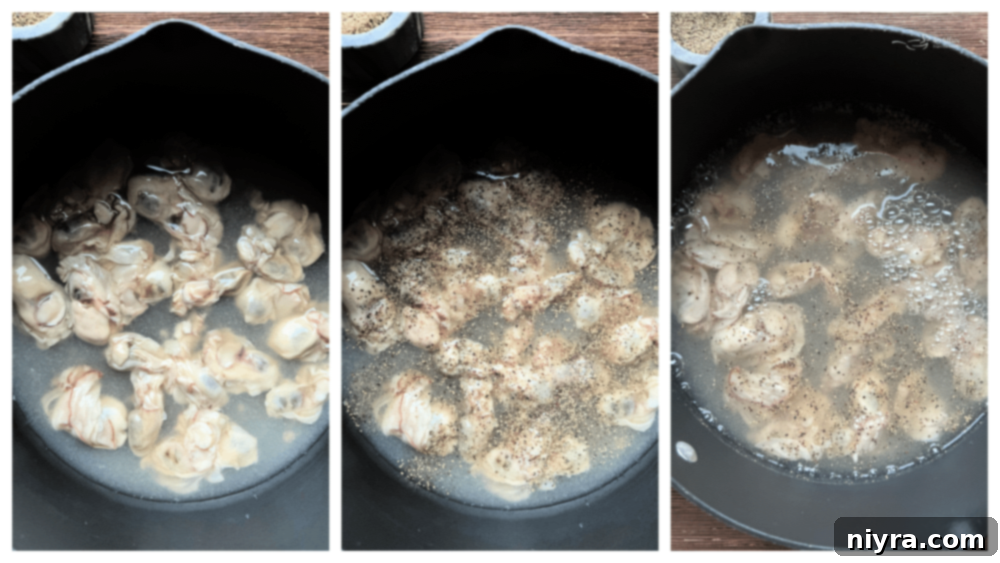
Crafting the Best Oyster Stew: Step-by-Step Guide
Making this incredible oyster stew is surprisingly simple, despite its gourmet appeal. Follow these steps for a perfect, comforting bowl:
- Prepare the Oysters: Begin by adding the fresh oysters and all of their precious liquid directly into a large saucepan or a Dutch oven. This briny liquid is crucial for developing the stew’s authentic flavor profile.
- Season and Cover: Generously sprinkle the oysters with salt and black pepper according to your taste preferences. Then, carefully pour in just enough water to barely cover the oysters. You don’t want to dilute the flavor, so a minimal amount of water is key.
- Initial Cooking of Oysters: Place a lid on the pan and cook the oysters over medium heat. It’s important to check the oysters frequently, giving them a gentle stir occasionally. The critical moment for doneness is when the delicate edges of the oysters just begin to curl. This usually takes less than 15 minutes.
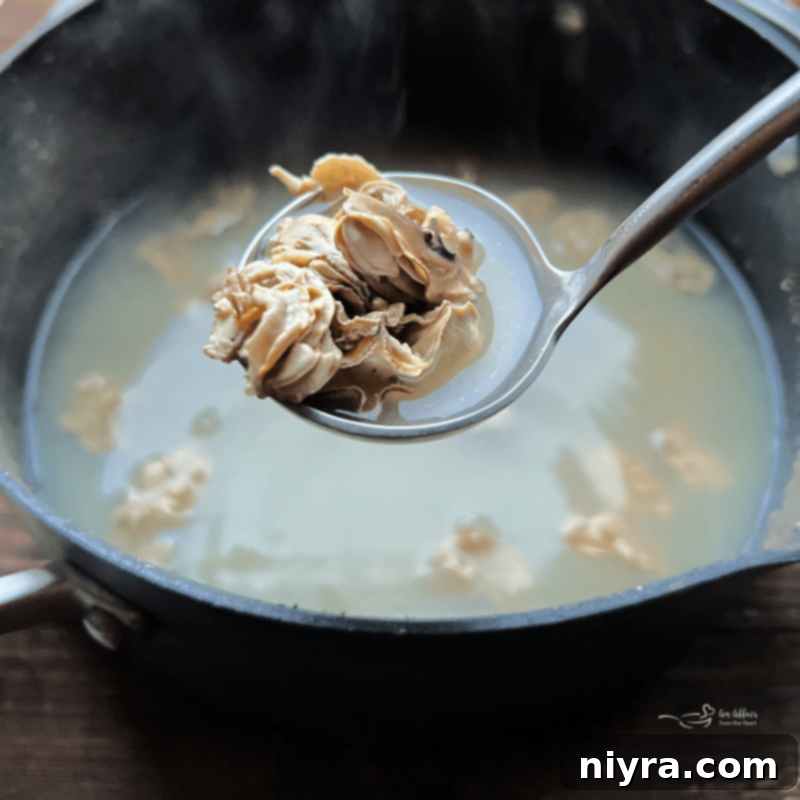
Note: It is absolutely essential to avoid overcooking the oysters. When overcooked, they become unpleasantly tough and rubbery. The goal is to cook them just until their edges briefly curl, ensuring they remain tender and succulent without losing their delicate texture.
- Incorporate the Butter: Once the oysters are perfectly cooked, add the stick of butter directly into the pan. This generous amount of butter is what gives the stew its characteristic richness and luxurious mouthfeel.

- Add the Milk: Next, pour in the whole milk (or cream/half-and-half, if using).
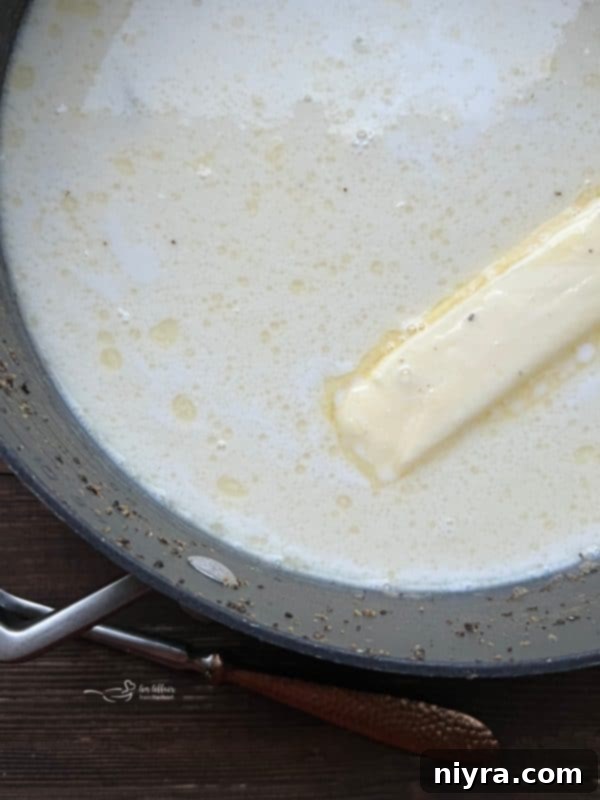
- Finish the Stew: Reduce the heat to medium-low. Gently stir the stew until the butter has completely melted and incorporated, and the broth is warmed through. Be careful not to boil the milk, as this can cause it to scald or curdle. As soon as the butter melts and the stew is hot, it’s done!
Taste the stew at this stage and adjust the seasoning as needed. You might find it beneficial to add a little more salt, pepper, or even an extra pat of butter to achieve your desired richness and flavor balance. Sometimes, depending on the oysters or the milk, it just needs that little extra something. Use your discretion and trust your palate!
Serve this exquisite oyster stew immediately, piping hot, alongside plenty of oyster crackers or thick slices of crusty bread for dipping.
Leftover oyster stew can be stored beautifully. Simply transfer it to an airtight container and refrigerate for up to 2-3 days. When reheating, do so gently on the stovetop over low heat or in the microwave, taking care not to let it boil, to maintain its creamy texture. You might even find that the flavors have melded and deepened, making it taste even better on the second day. However, I generally do not recommend freezing this soup, as the delicate texture of the oysters and the milk base can suffer during thawing.
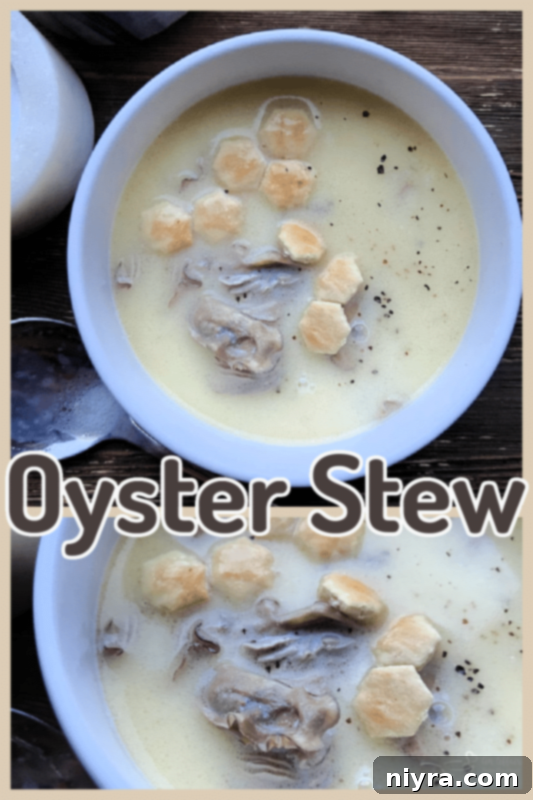
Love this Recipe? Pin it for Later!
Don’t let this delightful Homemade Oyster Stew Recipe slip away! Be sure to pin it to your favorite Pinterest board before you navigate away. It’s perfect for future holiday meals, cozy winter evenings, or whenever a craving for luxurious seafood strikes!
Perfect Serving Suggestions for Oyster Stew
While a bowl of oyster stew is often considered a complete and satisfying meal on its own, it can be effortlessly elevated and expanded to create a heartier, more elaborate dining experience. To complement its rich, creamy profile, consider pairing it with a crisp, refreshing side salad dressed with a light vinaigrette. The bright acidity of the salad provides a wonderful contrast to the stew’s richness. For those who enjoy dipping, baking a fresh French baguette or serving a rustic, crusty bread is an absolute must. The bread is perfect for soaking up every last drop of the delectable, buttery broth, ensuring no flavor goes to waste. A light white wine, such as a crisp Sauvignon Blanc or a dry Chardonnay, would also beautifully complement the delicate seafood flavors.

Oyster Stew: Expert Tips, Smart Substitutions & Flavorful Additions
Elevate your oyster stew experience with these insightful tips, easy substitutions, and exciting additions, ensuring every bowl is tailored to perfection:
- Source the Freshest Oysters: For the most exceptional flavor and texture, always seek out the freshest oysters possible. Ideally, purchase them from a reputable local seafood market where quality and freshness are paramount.
- Spice It Up or Brighten the Flavor: If you prefer a little kick, a dash of your favorite hot sauce or a pinch of red pepper flakes can add a wonderful warmth. Alternatively, a squeeze of fresh lemon juice at the end can brighten the briny flavors and add a zesty finish.
- Dairy Alternatives: While whole milk provides a balanced richness, feel free to substitute half and half or a blend of heavy cream and milk if you desire an even more decadent and thicker stew.
- Elegant Garnishes: For an enhanced visual appeal and a burst of fresh flavor, consider garnishing individual bowls with finely chopped fresh herbs such as parsley or chives, or thinly sliced green onions.
- Hearty Additions: To make your stew even more substantial, you can incorporate some pre-cooked, tender chunks of potatoes. For an extra layer of savory, coastal flavor, a sprinkle of Old Bay Seasoning can work wonders, adding a classic seafood seasoning touch.
This versatile stew truly shines for any occasion, from casual, comforting family dinners to elegant and special holiday meals. Its ability to warm from the inside out makes it an absolutely perfect choice for any chilly day, promising a delightful culinary experience every time.
Can Canned Oysters Be Used in this Oyster Stew Recipe?
Absolutely! The beauty of this oyster stew recipe lies in its adaptability. My Mom, a master of practical and delicious cooking, successfully made this very oyster stew recipe using canned oysters numerous times. She shared that she followed the same steps precisely, opting for jarred or canned oysters in their natural juices. This was often due to them being more economical and consistently available in our area, especially when fresh oysters were harder to come by. While fresh oysters offer a slightly superior texture, canned oysters still provide that distinct briny flavor and create a wonderfully satisfying stew, making it accessible to everyone, regardless of their location or budget.
Frequently Asked Questions About Oyster Stew
- What type of oyster works best for stew? Any fresh, raw oyster will yield excellent results. Popular choices like Blue Point, Malpeque, or Kumamoto are all fantastic. Generally, larger oysters tend to hold up better and maintain their integrity in a stew, offering a more substantial bite.
- Is oyster stew supposed to be thick? No, traditionally, oyster stew is not meant to be thick like a chowder. It should have a creamy, luxurious broth-like consistency. The natural starches released by the oysters, combined with the milk and butter, contribute to a slight, natural thickening, but it should remain pourable and smooth.
- How do you store and reheat leftovers? Leftover oyster stew should be stored in an airtight container in the refrigerator for up to 3 days. To reheat, gently warm it on the stovetop over low heat, stirring occasionally, or in the microwave. Be careful not to bring it to a vigorous boil, as this can cause the milk to curdle and the oysters to toughen.
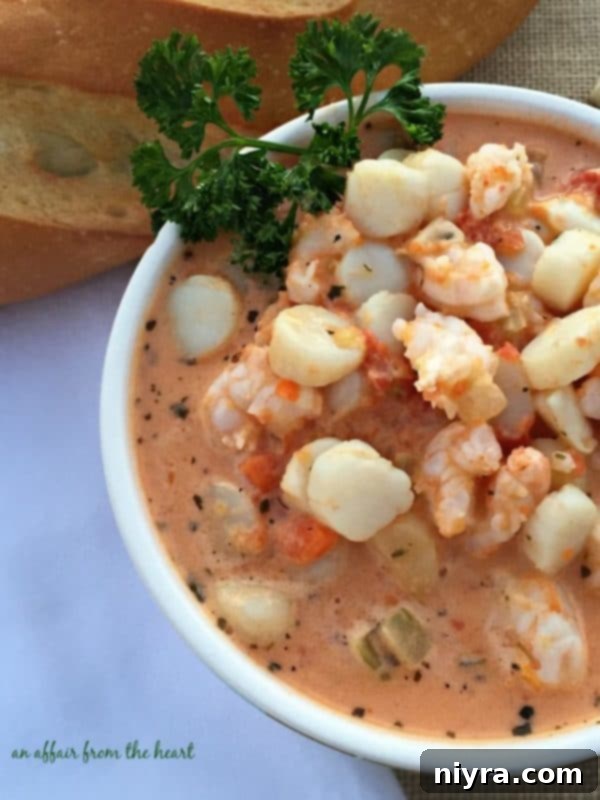
More Delightful Seafood Recipes to Explore
If you have a passion for seafood, you’ll love these additional recipes. You can discover ALL of my Seafood Recipes Here. Here are a few of my personal favorites that I highly recommend:
- Creamy Tomato Seafood Bisque (as pictured above) – A rich and flavorful bisque perfect for a special occasion.
- Shrimp & Crab Pasta – A luxurious pasta dish bursting with fresh seafood flavors.
- Instant Pot New England Clam Chowder – A quick and easy way to enjoy classic, hearty clam chowder.
- Mom’s Tuna Tetrazzini – A nostalgic, comforting casserole that’s a family favorite.
- How to Smoke Salmon – Master the art of smoking salmon for incredible flavor.
- Crab Rangoon Dip – All the flavors of your favorite appetizer in a delicious dip.
See ALL of my Soup Recipes for even more comforting bowls!
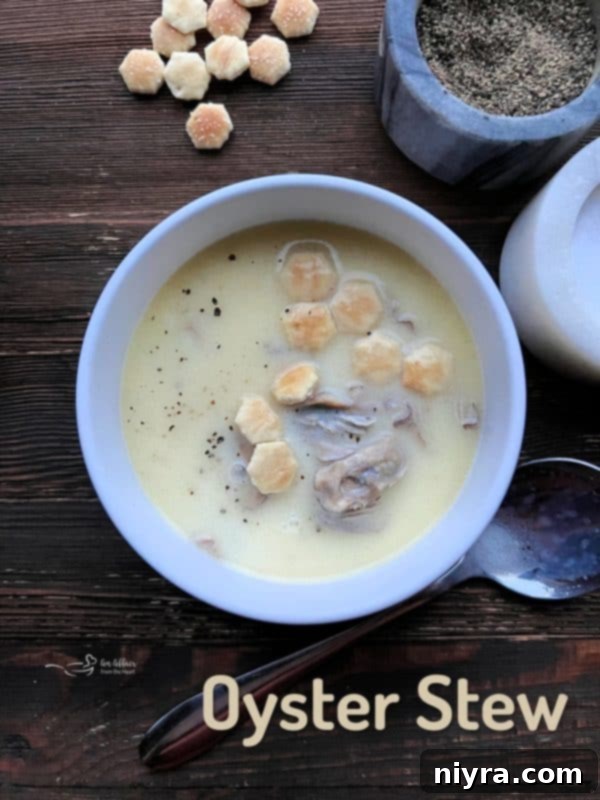
I sincerely hope that this cherished recipe for Oyster Stew not only brings warmth and flavor to your table but also inspires a long and memory-filled tradition in your home, just as it has in mine. May it create new stories and connections around your family meals for years to come.

The Best Oyster Stew Recipe
Oyster Stew is the ultimate comfort food, featuring tender oysters simmered in a rich, buttery milk-based broth. This classic recipe spotlights the sweet saltiness of fresh oysters with just a few simple ingredients. Enjoy a warm bowl of this hearty stew all winter long or for special occasions like Christmas Eve.
Prep Time
1 min
Cook Time
20 mins
Total Time
21 mins
Course: Soup
Cuisine: American
Keyword: butter, canned oysters, Christmas Eve Tradition, Lenten meal, meatless, milk, oyster stew, raw fresh oysters, seafood
Servings: 4 servings / makes about 5 cups
Calories: 111 kcal
Author: Michaela Kenkel
Equipment
- 12-inch Stainless Steel Soup Ladle
- Lodge 6 Quart Enameled Cast Iron Dutch Oven (Classic Red Enamel)
- AmazonBasics Enameled Cast Iron Covered Dutch Oven, 6-Quart, Blue
- Stainless Steel Stock Pot with Lid, 8-Quart
- Cuisinart Chef’s Classic Nonstick 1-Quart Saucepan with Lid
Ingredients
- 1 (16 ounce) container of fresh raw oysters in liquid
- 1 teaspoon salt
- 1 teaspoon black pepper
- 1 stick (1/2 cup) of butter
- Water (as needed)
- 2 cups whole milk
Instructions
- Add the oysters and their juice to a large saucepan or Dutch oven.
- Sprinkle with salt and pepper.
- Add water until the oysters are just covered.
- Place the pan on the stove and cook over medium heat until the oysters get curly around their edges. (This will take less than 15 minutes).
- Add in the stick of butter and the milk. Cook over medium-low heat until the butter melts. Take care not to cook it too high, as you don’t want to scald the milk.
- When the butter melts, the stew is done. Taste and add more salt, pepper, or butter if needed to achieve your desired flavor.
- Serve hot with oyster crackers or slices of crusty bread.
Notes
This recipe for oyster stew tastes great when eaten immediately, and also truly shines the next day. Store any leftovers in the refrigerator in an airtight container for up to 3 days before discarding. Reheat gently to preserve texture and flavor.
Nutrition
Serving: 1 | Calories: 111kcal | Carbohydrates: 7g | Protein: 5g | Fat: 7g | Saturated Fat: 4g | Polyunsaturated Fat: 2g | Cholesterol: 26mg | Sodium: 620mg | Sugar: 6g
